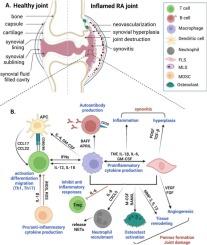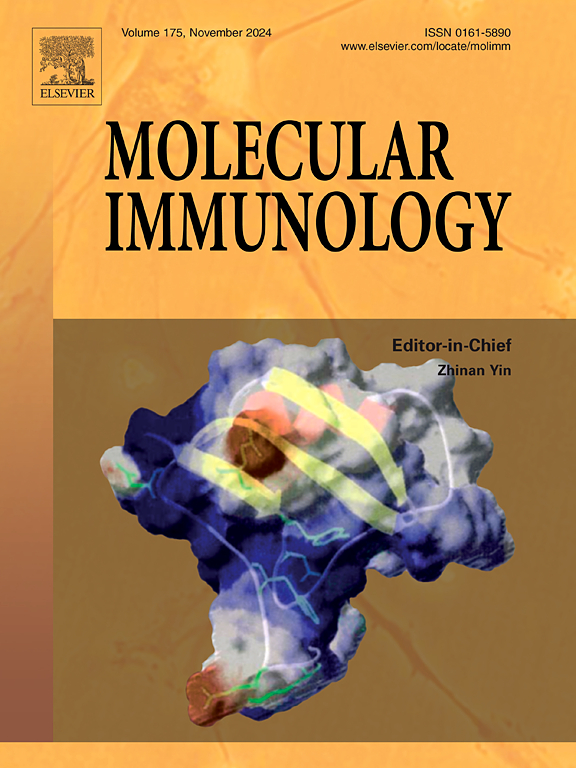Cellular interactions in maintaining an inflammatory microenvironment in rheumatoid arthritis
IF 3
3区 医学
Q2 BIOCHEMISTRY & MOLECULAR BIOLOGY
引用次数: 0
Abstract
Rheumatoid arthritis (RA) is a chronic autoimmune disease characterized by persistent inflammation and progressive joint destruction, driven by complex pathogenic mechanisms. Aberrant activation of various cellular components and their dynamic interactions contribute significantly to the onset and progression of RA. Key cell types involved include non-immune cells, such as fibroblast-like synoviocytes (FLS) and macrophage-like synoviocytes (MLS), innate immune cells (neutrophils, dendritic cells, and macrophages) and adaptive immune cells (B cells and T cells). These cells collectively release high levels of proinflammatory cytokines (e.g., TNF, IL-1β, IL-6, IL-17, GM-CSF, and lymphotoxins), chemokines (e.g., CCL17, CCL22, CXCL8 and CXCL10), growth factors (e.g., PDGF, and TGF-β), pro-angiogenic factors (e.g., VEGF and FGF), matrix metalloproteinases (e.g., MMP2 and MMP9), and autoantibodies (e.g., RF and ACPA) that collectively contribute to maintaining an inflammatory microenvironment in RA joints. These molecular mediators recruit and activate distinct cellular subsets that perpetuate inflammation. This review provides an overview of the major cellular subpopulations and their intricate interactions within the RA synovium that ultimately lead to sustained synovial inflammation, bone erosion and cartilage damage. In addition, some insights into the potential disruption of such cellular activations and interactions as therapeutic strategies to achieve better treatment outcomes are also provided.

类风湿关节炎中维持炎症微环境的细胞相互作用
类风湿性关节炎(RA)是一种慢性自身免疫性疾病,其特征是持续炎症和进行性关节破坏,由复杂的致病机制驱动。各种细胞成分的异常激活及其动态相互作用在RA的发生和发展中起着重要作用。关键细胞类型包括非免疫细胞,如成纤维细胞样滑膜细胞(FLS)和巨噬细胞样滑膜细胞(MLS)、先天免疫细胞(中性粒细胞、树突状细胞和巨噬细胞)和适应性免疫细胞(B细胞和T细胞)。这些细胞共同释放高水平的促炎细胞因子(如TNF、IL-1β、IL-6、IL-17、GM-CSF和淋巴毒素)、趋化因子(如CCL17、CCL22、CXCL8和CXCL10)、生长因子(如PDGF和TGF-β)、促血管生成因子(如VEGF和FGF)、基质金属蛋白酶(如MMP2和MMP9)和自身抗体(如RF和ACPA),它们共同有助于维持RA关节的炎症微环境。这些分子介质招募和激活不同的细胞亚群,使炎症永久化。本文综述了类风湿性关节炎滑膜中主要的细胞亚群及其复杂的相互作用,这些相互作用最终导致持续的滑膜炎症、骨侵蚀和软骨损伤。此外,还提供了一些关于这种细胞激活和相互作用的潜在破坏作为治疗策略以获得更好治疗结果的见解。
本文章由计算机程序翻译,如有差异,请以英文原文为准。
求助全文
约1分钟内获得全文
求助全文
来源期刊

Molecular immunology
医学-免疫学
CiteScore
6.90
自引率
2.80%
发文量
324
审稿时长
50 days
期刊介绍:
Molecular Immunology publishes original articles, reviews and commentaries on all areas of immunology, with a particular focus on description of cellular, biochemical or genetic mechanisms underlying immunological phenomena. Studies on all model organisms, from invertebrates to humans, are suitable. Examples include, but are not restricted to:
Infection, autoimmunity, transplantation, immunodeficiencies, inflammation and tumor immunology
Mechanisms of induction, regulation and termination of innate and adaptive immunity
Intercellular communication, cooperation and regulation
Intracellular mechanisms of immunity (endocytosis, protein trafficking, pathogen recognition, antigen presentation, etc)
Mechanisms of action of the cells and molecules of the immune system
Structural analysis
Development of the immune system
Comparative immunology and evolution of the immune system
"Omics" studies and bioinformatics
Vaccines, biotechnology and therapeutic manipulation of the immune system (therapeutic antibodies, cytokines, cellular therapies, etc)
Technical developments.
 求助内容:
求助内容: 应助结果提醒方式:
应助结果提醒方式:


